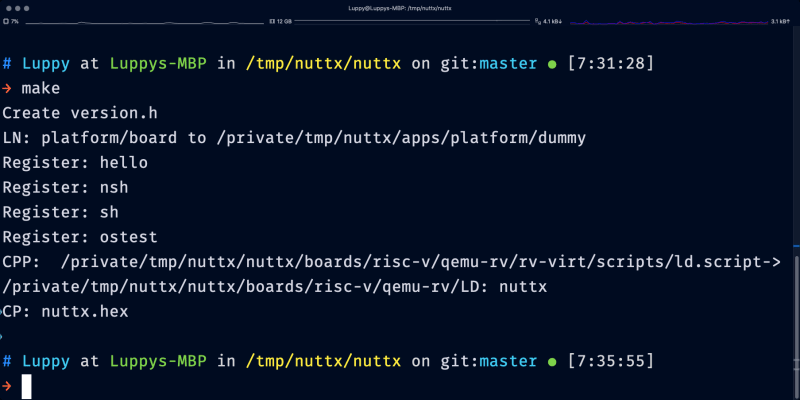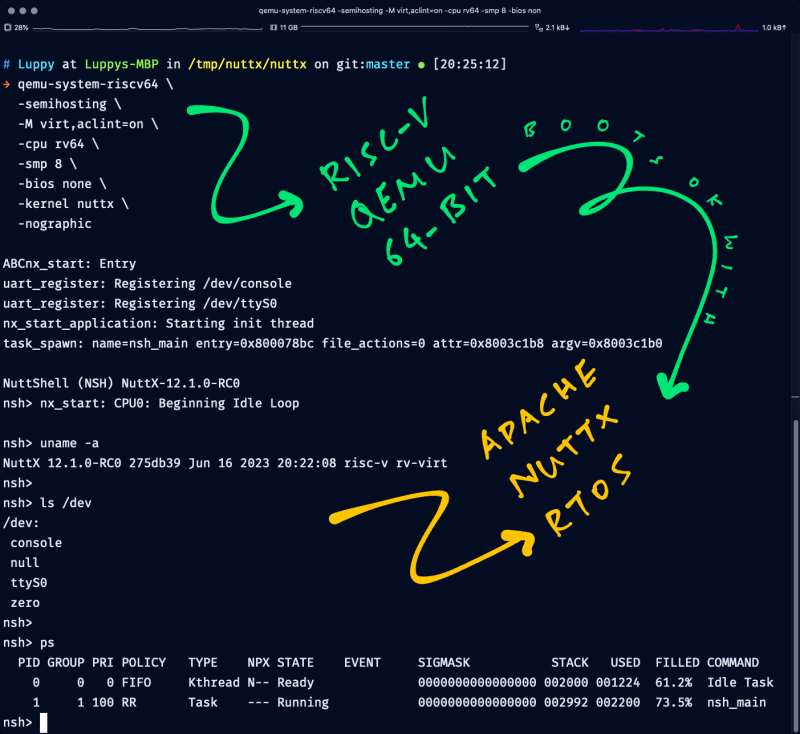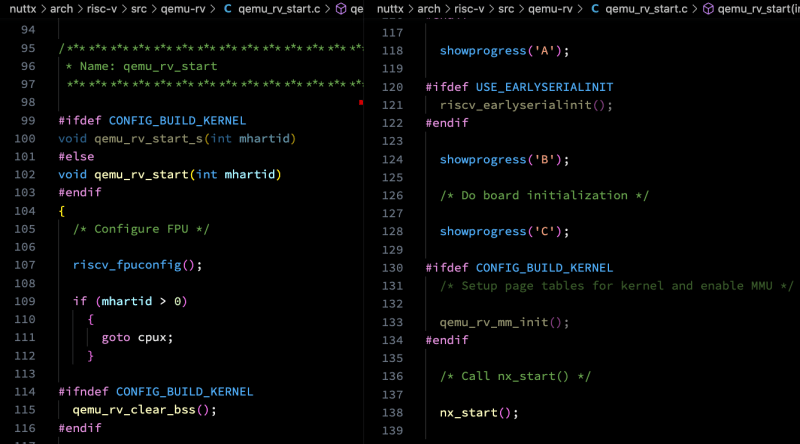Apache NuttX is a Real-Time Operating System (RTOS) that runs on many kinds of devices, from 8-bit to 64-bit.
(Think Linux, but a lot smaller and simpler)
In this article we'll...
Boot NuttX RTOS on a 64-bit RISC-V device
Explore the Boot Code that starts NuttX on RISC-V
And learn a little RISC-V Assembly!
But we need RISC-V Hardware?
No worries! We'll run NuttX on the QEMU Emulator for 64-bit RISC-V.
(Which will work on Linux, macOS and Windows machines)
Building Apache NuttX RTOS in 4 minutes
Boot NuttX on 64-bit RISC-V QEMU
We begin by booting NuttX RTOS on RISC-V QEMU Emulator (64-bit)...
-
Download and install QEMU Emulator.
For macOS we may use
brew...
brew install qemu -
Download
nuttxfrom the NuttX Release...nuttx: NuttX Image for 64-bit RISC-V QEMU
If we prefer to build NuttX ourselves: Follow these steps
-
Start the QEMU RISC-V Emulator (64-bit) with NuttX RTOS...
qemu-system-riscv64 \ -semihosting \ -M virt,aclint=on \ -cpu rv64 \ -smp 8 \ -bios none \ -kernel nuttx \ -nographic -
NuttX is now running in the QEMU Emulator! (Pic below)
uart_register: Registering /dev/console uart_register: Registering /dev/ttyS0 nx_start_application: Starting init thread NuttShell (NSH) NuttX-12.1.0-RC0 nsh> nx_start: CPU0: Beginning Idle Loop nsh> -
Enter "help" to see the available commands...
nsh> help help usage: help [-v] [<cmd>] . break dd exit ls ps source umount [ cat df false mkdir pwd test unset ? cd dmesg free mkrd rm time uptime alias cp echo help mount rmdir true usleep unalias cmp env hexdump mv set truncate xd basename dirname exec kill printf sleep uname Builtin Apps: nsh ostest sh -
NuttX works like a tiny version of Linux, so the commands will look familiar...
nsh> uname -a NuttX 12.1.0-RC0 275db39 Jun 16 2023 20:22:08 risc-v rv-virt nsh> ls /dev /dev: console null ttyS0 zero nsh> ps PID GROUP PRI POLICY TYPE NPX STATE EVENT SIGMASK STACK USED FILLED COMMAND 0 0 0 FIFO Kthread N-- Ready 0000000000000000 002000 001224 61.2% Idle Task 1 1 100 RR Task --- Running 0000000000000000 002992 002024 67.6% nsh_main
Let's talk about QEMU...
Apache NuttX RTOS on RISC-V QEMU
QEMU Emulator for RISC-V
Earlier we ran this command. What does it mean?
qemu-system-riscv64 \
-kernel nuttx \
-cpu rv64 \
-smp 8 \
-M virt,aclint=on \
-semihosting \
-bios none \
-nographic
The above command starts the QEMU Emulator for RISC-V (64-bit) with...
Kernel Image: nuttx
CPU: 64-bit RISC-V
Symmetric Multiprocessing: 8 CPU Cores
Machine: Generic Virtual Platform (virt)
Handle Interrupts with Advanced Core Local Interruptor (ACLINT)
(Instead of the older SiFive Core Local Interruptor CLINT)
- Enable Semihosting Debugging without BIOS
Which RISC-V Instructions are supported by QEMU?
QEMU's RISC-V Generic Virtual Platform (virt) supports RV64GC, which is equivalent to RV64IMAFDCZicsr_Zifencei (phew)...
| RV64I | 64-bit Base Integer Instruction Set |
| M | Integer Multiplication and Division |
| A | Atomic Instructions |
| F | Single-Precision Floating-Point |
| D | Double-Precision Floating-Point |
| C | Compressed Instructions |
| Zicsr | Control and Status Register (CSR) Instructions |
| Zifencei | Instruction-Fetch Fence |
We'll meet these instructions shortly.
QEMU Starts NuttX
What happens when NuttX RTOS boots on QEMU?
Let's find out by tracing the RISC-V Boot Code in NuttX!
Earlier we ran this command to generate the RISC-V Disassembly for the NuttX Kernel...
riscv64-unknown-elf-objdump \
-t -S --demangle --line-numbers --wide \
nuttx \
>nuttx.S \
2>&1
This produces nuttx.S, the disassembled NuttX Kernel for RISC-V.
nuttx.S begins with this RISC-V code...
0000000080000000 <__start>:
nuttx/arch/risc-v/src/chip/qemu_rv_head.S:46
__start:
/* Load mhartid (cpuid) */
csrr a0, mhartid
80000000: f1402573 csrr a0, mhartid
This says...
NuttX Boot Code is at qemu_rv_head.S
NuttX Kernel begins execution at address
0x80000000
(Why? What if NuttX is started by the U-Boot Bootloader?)
Now we head into the NuttX Boot Code...
RISC-V Boot Code for Apache NuttX RTOS
RISC-V Boot Code in NuttX
What's inside the NuttX Boot Code?
The RISC-V Assembly code in qemu_rv_head.S will...
Get the CPU ID
Check the Number of CPUs
Set the Stack Pointer
Disable Interrupts
Load the Interrupt Vector
Jump to qemu_rv_start
Let's decipher the RISC-V Instructions in our Boot Code...
Get CPU ID
This is how we fetch the CPU ID in RISC-V Assembly: qemu_rv_head.S
/* Load mhartid (cpuid) */
csrr a0, mhartid
Let's break it down...
-
csrris the RISC-V Instruction that reads the Control and Status Register
(Which contains the CPU ID)
-
a0is the RISC-V Register that will be loaded with the CPU ID.
According to the RISC-V EABI (Embedded Application Binary Interface), a0 is actually an alias for the Official RISC-V Register x10.
("a" refers to "Function Call Argument")
-
mhartidsays that we'll read from the Hart ID Register, containing the ID of the Hardware Thread ("Hart") that's running our code.
(Equivalent to CPU ID)
So the above code will load the CPU ID into Register x10.
(We'll call it a0 for convenience)
Disable Interrupts
To disable interrupts in RISC-V, we do this: qemu_rv_head.S
/* Disable all interrupts (i.e. timer, external) in mie */
csrw mie, zero
Which means...
-
csrwwill write to the Control and Status Register
(Which controls interrupts and other CPU settings)
-
miesays that we'll write to the Machine Interrupt Enable Register
(0 to Disable Interrupts, 1 to Enable)
-
zerosays that we'll read from Register x0...
Which always reads as 0!
Thus the above instruction will set the Machine Interrupt Enable Register to 0, which will disable interrupts.
(Yeah RISC-V has a funny concept of "0")
Wait for Interrupt
Now check out this curious combination of instructions: qemu_rv_head.S
/* Wait forever */
csrw mie, zero
wfi
From the previous section, we know that "csrw mie, zero" will disable interrupts.
But wfi will Wait for Interrupt...
Which will never happen because we disabled interrupts!
Thus the above code will get stuck there, waiting forever. (Intentionally)
(wfi is probably the only instruction common to RISC-V and Arm CPUs)
Load Interrupt Vector
RISC-V handles interrupts by looking up the Interrupt Vector Table.
This is how we load the Address of the Vector Table into the CPU Settings: qemu_rv_head.S
/* Load address of Interrupt Vector Table */
la t0, __trap_vec
csrw mtvec, t0
-
laloads the Address of the Vector Table into Register t0
(Which is aliased to Register x5)
csrwwrites t0 into the Control and Status Register at...mtvec, the Machine Trap-Vector Base-Address Register
Which will load the Address of our Interrupt Vector Table into the CPU Settings.
(la is actually a Pseudo-Instruction that expands to auipc and addi)
(auipc loads an Address Offset from the Program Counter)
(addi adds an Immediate Value to a Register)
32-bit vs 64-bit RISC-V
Adapting 32-bit code for 64-bit sounds hard... But it's easy peasy for RISC-V!
Our Boot Code uses an Assembler Macro to figure out if we're running 32-bit or 64-bit RISC-V: qemu_rv_head.S
#ifdef CONFIG_ARCH_RV32
/* Do this for 32-bit RISC-V */
slli t1, a0, 2
#else
/* Do this for 64-bit RISC-V */
slli t1, a0, 3
#endif
Which means that the exact same Boot Code will run on 32-bit AND 64-bit RISC-V!
(slli sounds "silly", but it's Logical Shift Left)
(CONFIG_ARCH_RV32 is derived from our NuttX Build Configuration)
Other Instructions
What about the other RISC-V Instructions in our Boot Code?
Let's skim through the rest...
-
bnezbranches to Label1fif Register a0 is Non-Zero
bnez a0, 1f
-
jjumps to Label2f
(We'll explain Labels in a while)
j 2f
-
liloads the Value 1 into Register t1
(li is a Pseudo-Instruction that expands to addi)
(addi adds an Immediate Value to a Register)
li t1, 1
-
bltbranches to Label3fif Register a0 is less than Register t1
(And grabs a sandwich)
blt a0, t1, 3f
-
addsets Register t0 to the value of Register t0 + Register t1
(t1 is aliased to Register x15)
add t0, t0, t1
-
REGLOADis an Assembly Macro that expands told
ld loads Register t0 into the Stack Pointer Register
(Which is aliased to Register x2)
REGLOAD sp, 0(t0)
-
jal(Jump And Link) will jump to the address qemu_rv_start and store the Return Address in Register x1
(Works like a Function Call)
jal x1, qemu_rv_start
-
retreturns from a Function Call.
(ret is a Pseudo-Instruction that expands to jalr)
(jalr "Jump And Link Register" will jump to the Return Address stored in Register x1)
ret
(See the list of all RISC-V Instructions)
(And RISC-V Pseudo-Instructions)
Why are the RISC-V Labels named "1f", "2f", "3f"?
"1f" refers to the Local Label "1" with a Forward Reference.
(Instead of a Backward Reference)
Let's jump to qemu_rv_start...
RISC-V Start Code for NuttX RTOS
Jump to Start
Our Boot Code jumps to qemu_rv_start...
What happens next?
qemu_rv_start is the very first C Function that NuttX runs when it boots on QEMU.
The function will...
Configure the Floating-Point Unit
Clear the BSS Memory
Initialise the Serial Port
-
Initialise the Memory Management Unit
(For Kernel Mode only)
Call nx_start
What happens in nx_start?
nx_start will initialise a whole bunch of NuttX things...
Which will start the NuttX Shell that we've seen earlier.
And that's how NuttX RTOS boots on QEMU Emulator for RISC-V!
Why are we doing all this?
We're about to port NuttX to the StarFive JH7110 RISC-V SoC and Pine64 Star64 Single-Board Computer.
The analysis we've done today will be super helpful as we write the Boot Code for these RISC-V devices.
Stay tuned for updates in the next article!
What's Next
I hope this article has been an educational exploration of Apache NuttX RTOS on 64-bit RISC-V...
We booted NuttX RTOS on an emulated 64-bit RISC-V device
We peeked at the Boot Code that starts NuttX on RISC-V
And hopefully we learnt a little RISC-V Assembly!
As we've seen, NuttX is a tiny operating system that's perfect for experimenting with RISC-V gadgets. We'll do this and much more in the upcoming articles!
(We welcome your contribution to Apache NuttX RTOS)
Many Thanks to my GitHub Sponsors for supporting my work! This article wouldn't have been possible without your support.
Got a question, comment or suggestion? Create an Issue or submit a Pull Request here...
lupyuen.github.io/src/riscv.md
Appendix: Build Apache NuttX RTOS for 64-bit RISC-V QEMU
The easiest way to run Apache NuttX RTOS on 64-bit RISC-V is to download the NuttX Image and boot it on QEMU Emulator...
But if we're keen to build NuttX ourselves, here are the steps...
-
Install the Build Prerequisites, skip the RISC-V Toolchain...
-
Download the RISC-V Toolchain for riscv64-unknown-elf...
-
Download and configure NuttX...
mkdir nuttx cd nuttx git clone https://github.com/apache/nuttx nuttx git clone https://github.com/apache/nuttx-apps apps cd nuttx tools/configure.sh rv-virt:nsh64 make menuconfig -
In menuconfig, browse to "Build Setup > Debug Options"
Select the following options...
Enable Debug Features Enable Error Output Enable Warnings Output Enable Informational Debug Output Enable Debug Assertions Scheduler Debug Features Scheduler Error Output Scheduler Warnings Output Scheduler Informational OutputSave and exit menuconfig.
-
Build the NuttX Project and dump the RISC-V Disassembly...
make V=1 -j7 riscv64-unknown-elf-objdump \ -t -S --demangle --line-numbers --wide \ nuttx \ >nuttx.S \ 2>&1 -
If the build fails with...
sed: 1: "/CONFIG_BASE_DEFCONFIG/ ...": bad flag in substitute command: '}'Please run "make menuconfig > Build Setup > Debug Options" and uncheck "Enable Debug Features". Save, exit menuconfig and rebuild NuttX with make.
This produces the NuttX Image nuttx that we may boot on QEMU RISC-V Emulator...
Let's look at the GCC Command that compiles NuttX for 64-bit RISC-V QEMU...
Appendix: Compile Apache NuttX RTOS for 64-bit RISC-V QEMU
From the previous section, we see that the NuttX Build compiles the source files with these GCC Options...
riscv64-unknown-elf-gcc \
-c \
-fno-common \
-Wall \
-Wstrict-prototypes \
-Wshadow \
-Wundef \
-Os \
-fno-strict-aliasing \
-fomit-frame-pointer \
-ffunction-sections \
-fdata-sections \
-g \
-march=rv64imac \
-mabi=lp64 \
-mcmodel=medany \
-isystem nuttx/include \
-D__NuttX__ \
-DNDEBUG \
-D__KERNEL__ \
-pipe \
-I nuttx/arch/risc-v/src/chip \
-I nuttx/arch/risc-v/src/common \
-I nuttx/sched \
chip/qemu_rv_start.c \
-o qemu_rv_start.o
The RISC-V Options are...
- march=rv64imac: This generates Integer-Only 64-bit RISC-V code, no Floating-Point.
Which is surprising because RISC-V QEMU actually supports Floating-Point.
We'll fix this as we port NuttX to the StarFive JH7110 RISC-V SoC and Pine64 Star64 SBC.
- mabi=lp64: This Application Binary Interface says that Long Pointers are 64-bit. No Floating-Point Arguments will be passed in Registers.
We might fix this for JH7110 SoC and Star64 SBC.
- mcmodel=medany: Sounds like a burger (or fast-food AI model) but it actually generates code for the Medium-Any Code Model. (Instead of Medium-Low)
Appendix: Download Toolchain for 64-bit RISC-V
Follow these steps to download the 64-bit RISC-V Toolchain for building Apache NuttX RTOS on Linux, macOS or Windows...
- Download the riscv64-unknown-elf RISC-V Toolchain for Linux, macOS or Windows...
- [__Ubuntu Linux__](https://static.dev.sifive.com/dev-tools/freedom-tools/v2020.12/riscv64-unknown-elf-toolchain-10.2.0-2020.12.8-x86_64-linux-ubuntu14.tar.gz)
- [__CentOS Linux__](https://static.dev.sifive.com/dev-tools/freedom-tools/v2020.12/riscv64-unknown-elf-toolchain-10.2.0-2020.12.8-x86_64-linux-centos6.tar.gz)
- [__macOS__](https://static.dev.sifive.com/dev-tools/freedom-tools/v2020.12/riscv64-unknown-elf-toolchain-10.2.0-2020.12.8-x86_64-apple-darwin.tar.gz)
- [__Windows MinGW__](https://static.dev.sifive.com/dev-tools/freedom-tools/v2020.12/riscv64-unknown-elf-toolchain-10.2.0-2020.12.8-x86_64-w64-mingw32.zip)
Extract the Downloaded Toolchain
-
Add the Extracted Toolchain to the
PATHEnvironment Variable...
riscv64-unknown-elf-toolchain-.../bin -
Check the RISC-V Toolchain...
riscv64-unknown-elf-gcc -v







Top comments (0)